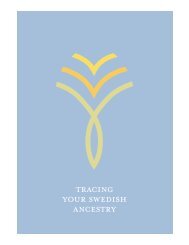Election Guide 2002 - Sweden.se
Election Guide 2002 - Sweden.se
Election Guide 2002 - Sweden.se
Create successful ePaper yourself
Turn your PDF publications into a flip-book with our unique Google optimized e-Paper software.
After the general election in 1994, the Social<br />
Democrats returned to power (with 161 <strong>se</strong>ats out of<br />
349) and formed a new government with Ingvar Carlsson<br />
as Prime Minister. In March 1996 Ingvar Carlsson<br />
resigned and was succeeded by Göran Persson, the new<br />
chairman of the Social Democratic Party.<br />
In the 1998 election, the foundations of the government<br />
were weakened. Nevertheless, the Persson Government<br />
remained in power (with 131 <strong>se</strong>ats out of 349) and cooperated<br />
with the Left Party and the Green Party in the<br />
Riksdag.<br />
How the system works today<br />
Proportional repre<strong>se</strong>ntation<br />
Parliamentary elections employ a system of proportional<br />
repre<strong>se</strong>ntation designed to ensure a distribution of <strong>se</strong>ats<br />
among the parties in proportion to the votes cast for<br />
them nationally.<br />
Proportional fairness is not primarily achieved in each<br />
constituency but in the whole country regarded as a<br />
single constituency. Hence, in addition to 310 fixed<br />
constituency <strong>se</strong>ats, 39 <strong>se</strong>ats are distributed at large so<br />
as to obtain a fair, nationally proportional result.<br />
However, the at-large <strong>se</strong>ats are also filled by candidates<br />
from the parties’ regular electoral lists.<br />
There is one exception to the rule of complete<br />
national proportionality: a quota rule intended to<br />
prevent very small parties from gaining repre<strong>se</strong>ntation<br />
in the Riksdag. A party must thus receive at least 4% of<br />
the national popular vote to qualify for any <strong>se</strong>ats. In any<br />
one constituency, however, a party can gain a <strong>se</strong>at by<br />
obtaining 12% of the votes, even if its national popular<br />
vote falls short of 4%.<br />
Dissolution of the Riksdag<br />
The government has the right to dissolve the Riksdag<br />
and call an extraordinary election between the ordinary,<br />
regularly scheduled elections. However, the mandate of<br />
an extraordinary election is valid only for the remaining<br />
portion of the regular parliamentary term of office. No<br />
extra election has been held in <strong>Sweden</strong> since the current<br />
constitution came into force in 1975.<br />
9












